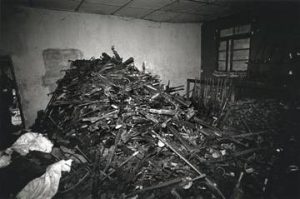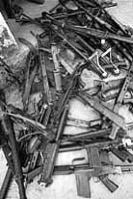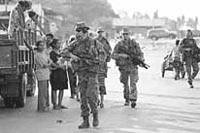by Brian Wilson
Combating the transport and distribution of weapons of mass destruction (WMD) has garnered the attention of much of the world’s media over the past decade but the cheap and simple AK-47 rifle and other small arms now numbering more than 600 million weapons also pose a significant threat to global order. -The Editor

While combating the transport and distribution of weapons of mass destruction (WMD) has garnered impressive international action this decade, a 15-year journey to regulate the equally deadly and destabilizing “small arms and light weapons” (SALW) has thus far failed to produce a comprehensive treaty. Reaching consensus on how to regulate the transfer and distribution of the AK-47 and the more than 600 million SALW1 has proved particularly challenging because it requires balancing national security interests with internationally accepted regulatory protocols.

Ambitious efforts that began in 1995 to produce a comprehensive Arms Trade Treaty (ATT) are still being debated (the next session at the United Nations is July 12-23, 2010), despite high-profile support. UN Secretary General Ban Ki-moon, “has identified as a ‘recurring problem’ the absence of a normative framework for all states to guide decisions regarding arms transfers.”2 In October 2009, U.S. Secretary of State Hilary Clinton said the United States “is committed to actively pursuing a strong and robust treaty that contains the highest possible, legally-binding standards for the international transfer of conventional weapons.”3
But after years of discussions, meetings and exchanges of diplomatic notes, no consensus document has emerged. A Treaty Conference is slated for 2012; thus, the next two years will be decisive in determining whether support exists for concluding this transformative agrement. The ATT would represent the first international agreement of its kind.4

“Presently, a single comprehensive legally binding instrument for regulating the international transfer of conventional weapons does not exist. For pragmatic reasons, existing conventional weapons treaties, such as the Ottawa Convention and the Convention on Certain Conventional Weapons are limited in scope and regulate only specific types of arms trafficking.”5 The development of the ATT, even though not final, represents, “a shift from a culture of reaction to a culture of prevention.”6
The concept of a comprehensive ATT began when “a group of Nobel Peace Laureates and non-governmental organizations proposed the establishment of a set of criteria to guide conventional weapons transfers…While it is accepted that conventional arms play a legitimate role in the maintenance of national security, it is argued that an arms trade treaty is necessary to establish a set of legally-binding international principles to govern the trade in conventional arms and set out a practical mechanism for their application.”7

The threat is certainly recognized: A United Nations report concluded “small arms and light weapons are the weapons of choice in many contemporary conflicts…hundreds of thousands of children have been among the victims of [SALW] or have been exploited as participants in conflicts in which these arms are used.”8 U.S. Under Secretary of State Ellen Tauscher remarked that the ATT “is worth doing because it can have, unlike many things we do, a more immediate impact. Lessening the arms trade can lead to less killing and maiming. But the reality is that this is a very big challenge.”9
Secretary Tauscher added, “I know that conventional arms have gotten much less attention even though they kill more people every year than nuclear, chemical or biological weapons…The United States is strongly committed to addressing the problems posed by the irresponsible transfers of conventional weapons.”10
State and private companies manufacture more than 8 million guns annually. In 2008, the United States inked $37.8 in weapons agreements, comprising 68.4 percent of authorized global arms.11 While there is clearly a legitimate market and use for such weapons, there is also thriving illicit arms trade that is worth billions a year.12 SALW’s have had a uniquely corrosive effect on stability and development in multiple states because they are, “…lethal, are relatively cheap, easily portable and concealable and, in most cases, require minimal maintenance and logistical support and they can therefore be operated relatively easily.”13
 |
 |
| Ruanda | East Timor |
As a result of the SALW’s damaging impact, substantively regulating SALW has been exhaustively examined in international and regional venues, most notably a 2001 United Nations Plan of Action to “prevent, combat and eradicate” the illicit trade of SALW as there is no comprehensive international accord to regulate such sales. Former United Nations Secretary-General Kofi Annan declared, “the carnage caused by small arms and light weapons…[is] not just one of disarmament, but also one of development, democracy, human rights and human security. And their illicit trade was conspicuous for its lack of a framework of binding norms and standards.”14 In pursuing agreement on an international SALW accord, the UN embarked on an ambitious initiative that has taken close to a decade.

The SALW threat exists globally, but is acutely damaging in Africa: an estimated 30 million15 small arms are in circulation in sub-Saharan Africa and 100 million on the continent. Approximately 95 percent of the weapons and ammunition used in Africa are manufactured outside the continent, which obviously requires transportation and a distribution network.16 In state-sanctioned trade, 99 percent of arms, or $58.5 million, came from outside the continent.17 Moreover, armed conflict may cost Africa $18 billion a year, with one estimate asserting it has cost Africa $284 billion since 1990. 18
Regulating SALW is critical in Africa because 38 percent of the globe’s conflicts are occurring there.19 “Perhaps (the) most urgent problem in Africa is to halt the proliferation of illicit small arms…the continent is deluged with light weapons in the wrong hands…”20 In African countries with conflicts, there is 50 percent more infant deaths, 15 percent more undernourished people, life expectancy is reduced, 20 percent more adult illiteracy, 2.5 fewer doctors per patient, and 12.4 percent less food per person.21 Moreover, “conflict leads to lost educational opportunities for children, as it destroys education infrastructure, reduces spending on schools and teachers and prevents children from attending classes.”22
In a survey conducted in 2003, the infiltration of weapons was recorded as the major cause of instability in northern Kenya. “Many African countries aren’t in a good position to address the problem. There are initiatives, but they’re difficult to enforce. Small arms are simply out of control.”23

The most popular weapon in Africa, and the world, is the Kalashnikov and its derivatives, which are easy to acquire and use. One example: AK-47s are sold in Somalia’s Bakara market. A 2001 article noted that, “Weapons like AK-47s made in Russia and North Korea sell for $200…The cheapest American-made ones trade for about $100…You go to the market buy a gun and start a war straightaway, its that easy. I have two rifles of my own for protection.”24 More than 1 million assault rifles are estimated to be in circulation in Mogadishu and the Angolan government reportedly distributed 700,000 rifles to assist in the battle against rebels.25 In southern Sudan, it is believed that almost every family possesses an AK-47.26
A “group of government experts” (GGE) has been established under the direction of the United Nations to “examine the feasibility, scope and draft parameters of a comprehensive, legally binding instrument establishing common international standards for the import, export and transfer of conventional arms.”27 Algeria, Egypt, Kenya, Nigeria and South Africa participated in the GGE and presented a report to the United Nations in 2008, noting, among things, that “arms embargoes were violated on certain occasions, and recognized that global arms production and trade contributed significantly to the economy and employment in a number of countries.”28

On a regional level, a promising initiative, the 2004 Nairobi Protocol for the Prevention, Control and Reduction of Small Arms and Light Weapons signaled the commitment of African states to curb illicit SALW.29 “The protocol requires states to pass laws outlawing the illicit manufacture, trafficking, possession and misuse of small arms and light weapons.”30 The Kenyan Foreign Minister, Kalonzo Musyoka, remarked that the 11-state accord “…is a very powerful signal to the world that our region is determined to eliminate small arms and lights weapons.”31
The Czech Government sponsored a workshop for West African states in September 2009 that focused on “implementation of the international instrument (the International Tracing Instrument, adopted by United Nations member states) to enable states to identify and trace, in a timely and reliable manner, illicit small arms and light weapons.”32 This ambitious capacity-building meeting addressed marking weapons, records keeping and cooperation in support of the ITI.
In another regional initiative executed earlier in the decade, Ethiopia, Kenya, Nigeria, Senegal, South Africa and Uganda implemented the Bamako Declaration on an African Common Position on the Illicit Proliferation, Circulation and Trafficking of Small Arms and Light Weapons. The Bamako Declaration produced mixed reviews, with commendable political commitments, but weak implementation. “Efforts to improve the capacity of the national law enforcement agencies to deal with SALW have been less than impressive…However, there is commendable progress at the regional level, particularly in West and South Africa…(And) there is no significant progress in the realm of concluded bilateral agreements on issues of small arms, but a host of multilateral frameworks exists…. On raising public awareness, significant progress has been achieved.”33
Other regional efforts are occurring, such as a recent meeting in Mombasa, Kenya to harmonize legislation on illegal arms and review the Regional Centre on Small Arms (RESCA). Efforts to achieve consistent punishments will increase the legitimacy, the rule of law and the ability to punish. RESCA is a promising effort to, among other things, identify points of national contact for coordination and illustrate a state’s commitment to combating illicit arms.

A treaty that regulates weapons must prohibit arms transfers that, “are likely to be used to commit serious violations of international humanitarian law, commit serious violations of international human rights law, or undermines sustainable development.”34 Moreover, in response to sovereignty and self-defense concerns, the NGO stated, “The ATT will not prevent the responsible transfer of weapons for defence, policing, peacekeeping, or other legitimate purposes. It will not prevent a transfer if it is legal under the national laws of all countries concerned, legal under international laws, and upholds best practice, particularly in ensuring that the arms are not likely to be diverted to another user.”35
Determining what weapons will be regulated and what transactions36 will constitute a transfer are enormously difficult issues that will require compromise. Existing national laws have been unable to meaningfully address the complex SALW challenges. Former UN Secretary-General Annan lamented that the lack of a framework of binding norms and standards for SALW transfers.37 In part that is because “efforts to combat illicit arms trafficking are in some cases hampered by inadequate national systems to control stocks and transfers of arms, shortcomings or differences in the legislation and enforcement mechanisms between the States involved, and a lack of information exchange band cooperation at the national, regional and international levels.”38
The broader issue of balancing national security interests with regulatory protocols is the most difficult issue in developing SALW protocols. Other challenges include arms traffickers who frequently bypass local laws and protocols for governments which are actively engaged in selling – and authorizing the export – of weapons. There are examples though, of states agreeing to proscribe weapons, such as regional action39 in Africa. International examples exist as well. Member-states at the International Maritime Organization approved amendments to the criminal law treaty, Suppression of Unlawful Acts (SUA), in 2005. The Amendments provide, for the first time in a treaty, a framework for criminalizing the conduct of those who illicitly ship chemical, radiological, nuclear and biological weapons (WMD), the transport of terrorists, or the use a ship as a weapon. The Amendments also provide enforcement mechanisms to facilitate non-flag State boarding of vessels suspected of being involved in such illicit activity and mandate that a state party either prosecutes or extradites suspected SUA offenders.
The SUA Amendments could serve as a model for the final stages of the Arms Trade Treaty. In October 2008, 147 States favorably endorsed, “moving forward with the negotiation of a comprehensive U.N. treaty to regulate the trade of conventional weapons worldwide…On 24 December (2008), the General Assembly officially adopted the draft resolution, Towards an Arms Trade Treaty: Establishing Common International Standards for the Import, Export and Transfer of Conventional Arms.”40
Even though a final document has not yet been produced, remarks by state representatives at the United Nations are encouraging. The French delegate, Yves Doutriaux, said “Of particular importance…was ensuring that States abstained from supplying such weapons to non-State entities or groups. Also, a preventative disarmament mechanism must be developed… Practical measures for the collection and destruction of weapons were of crucial importance.”41
The United Kingdom delegate, Stewart Eldon, sagely noted the UN efforts to combat SALW, “signaled a change in international efforts to control the spread and misuse of small arms. It must be regarded as a start of a long process of implementation, with a practical follow-up. The success of the Conference would be measured by the extent of its impact on the illicit trade and accumulation of small arms and light weapons in the world.”42
The Chinese delegate, Wang Yingfan, remarked that the excessive accumulation of illegal SALW was most salient in Africa. A PRC proposal recommends that “countries should [first] formulate and improve their legislation and regulations on the production, possession, holding and stockpiling of small arms, as well as take practical measures to ensure strict enforcement. Second…countries and regions should step up their cooperation and coordination in combating the illicit trade. Third, the international community should further support countries and regions in their efforts to deal with the issue of small arms. Fourth, while seeking to end tensions and conflicts, the international community should also make vigorous efforts to help affected countries develop their economies, eradicate poverty and realize sustainable development, endurable peace, as well as stability. Such actions would uproot the illicit trade in small arms and light weapons from its breeding grounds. The sovereignty of States must be respected and their right to legal production, possession and transfer of small arms should not be compromised.”43
After years of development, reaching final agreement on an ATT will require the investment of senior political leadership and resources prior to the 2012 UN Conference. Despite the significant outstanding issues, three arms transfer control conferences convened in Africa, Tanzania (2005) and two in Nairobi (2006 and 2008) provide hope.
The Agreement reached in Tanzania states that it “must ensure that all transfers are authorized through a physical permit or license, existing obligations under relevant international law should be respected, arms embargoes imposed by the UN Security Council should be respected and enforced and when permits or licenses are issued, consideration should be given to the risk of exports arms being used in the commission of serious violations of human rights or international humanitarian law, including the risk that such arms might be diverted into the wrong hands, such as those of terrorists; and that may affect regional and/or international security and stability.”44
The September 2008 Nairobi conference led to an agreement that the ATT should have respect for state sovereignty and the right to self-defense, focus on conflict prevention, management and resolution, have transparency and accountability, ensure governance and the fight against corruption, promote and protect human rights and promote sustainable development and the eradication of poverty.45
As a result of the devastating conflicts that have engulfed portions of Africa, among other places, an ATT will support reduction in illicit arms, standardize import and export criteria, ensure greater respect for the rule of law, increase transparency and accountability in arms procurements and emphasize developmental needs.46
A key challenge with any international accord is the level of specificity and in particular with the ATT, the unintended consequences of impairing a states’ ability to lawfully acquire weapons. In their statements to the UN Secretary General, Algeria, Nigeria, Egypt, Kenya and South Africa all referred to one or more of the principles in the UN Charter relating to the right of States to individual and collective self-defense, in accordance with Article 51 of the Charter of the United Nations, the right of States to manufacture, export, import or transfer arms, the right of self-determination and liberation struggles.”47 Nigeria, “appealed to countries …to look beyond their national interests and show more flexibility towards achieving an ATT.” 48![]()
End Notes
1 Alexander G. Higgins, UN-backed study estimates 639 million, Associated Press, June 24, 2002. “An estimated 639 million small arms are held by individuals, police, military and guerrillas around the world,” according to a Geneva’s Graduate Institute of International Studies project. The majority of small arms are privately owned, followed by government armed forces, police and insurgents. Approximately 20 percent, or more than 100,000 of small arms that are in existence today are from the Kalashnikov family, which includes AK-47s.
2 Towards an Arms Trade Treaty; United Nations; available at: http://www.un.org/disarmament/convarms/ArmsTradeTreaty/html/ATT.shtml
3 Ibid.
4 Zach Wall and Lauren Nicole Hill, SA/LW and the Arms Trade Treaty, The Journal of ERW and Mine Action, Issue 13.1 Summer 2009.
5 Ibid.
6 Prevention of Armed Conflict, United Nations General Assembly, A/55/985-S/2001/574, & June 2001, page 8.
7 Dominique Dye, Africa and an Arms Trade Treaty, The institute for Security Studies, ISS, Occasional Paper 191, August 2009.
8 Report of the Group of Governmental Experts on Small Arms, United Nations General Assembly, A/54/258, Item 76(f) of the provisional agenda, 19 August 1999, page 2.
9 The United States Mission to the European Union, Arms Trade Treaty, February 18, 2010, available at: http://useu.usmission.gov/Article.asp?ID=54f5ad85-2fb6-4565-9fe2-656309f49449 .
10 The United States Mission to the European Union, Arms Trade Treaty, February 18, 2010, available at: http://useu.usmission.gov/Article.asp?ID=54f5ad85-2fb6-4565-9fe2-656309f49449 (accessed on March 3, 2010).
11 Thom Shanker, Despite Slump, U.S. Role as Top Arms Supplier Grows, New York Times, September 7, 2009. “The growth of weapons sales by the United States last year was particularly noticeable against worldwide trends. The value of global arms sales in 2008 was $55.2 billion, a drop of 7.6 percent from 2007 and the lowest total for international weapons agreements since 2005.”
12 Alister Doyle, Action Urged on Deadly Small Arms Trafficking, Reuters, April 23, 2003. See also, Ben Case, Inching Toward a Global Arms Treaty, Terraviva, July 17, 2007. The UN-study estimated that at least 3,000 are injured daily. Small arms include, “pistols, assault rifles, light machine guns, submachine guns, mortars, portable anti-aircraft guns, grenade launchers, anti-tank missiles and rocket systems, hand grenades and anti-personnel landmines.” See also, Samrat Choudhury, Small Arms, Large Casualties, Hindustan Times, April 23, 2003, “Does the availability of these guns cause the deaths? Or would people have killed each other with sticks and stones if they had nothing else to do it with? The expert view is that it’s a bit of both.”
13 Report of the Group of Governmental Experts on Small Arms, United Nations General Assembly, A/54/258, Item 76(f) of the provisional agenda, 19 August 1999, page 8.
14 In Wake of Assembly Conference on Small Arms, Security Council Examines Its Role in Implementation of Action Programme, United Nations Press Release SC/7114, February 8, 2001.
15 Joyce Mulama, Worth the Paper It’s Written On? Inter Press Service, April 28, 2004.
16 Africa’s Missing Billions, International Arms Flows and the Cost of Conflict, Briefing Paper 107, IANSA, OXFAM, and Safeworld, October 2007, page 1.
17 Ibid., page 20.
18 Ibid., page 3.
19 Ibid., page 5.
20 Ken Opala, How to Thwart Merchants of Death, Nation (Nairobi), August 15, 2002.
21 Africa’s Missing Billions, International Arms Flows and the Cost of Conflict, Briefing Paper 107, IANSA, OXFAM, and Safeworld, October 2007, page 6.
22 Ibid., page 16.
23 Olivia Ward, Fuelling Africa’s Turmoil, Toronto Star, May 27, 2006.
24
Joseph Hazeley, Africa in the Firing Line, BBC, July 8, 2001.
25 Joseph Hazeley, Africa in the Firing Line, BBC, July 8, 2001. In, “South Africa, for example, guns are everywhere. Four million are registered and millions more held illegally. Children take then to school. They are used in car-jackings, robberies, burglaries, domestic disputes and at drinking places, putting South Africa among the most violent and crime riddled in the world.”
26 Cahil Milmo and Kate Holt, Global Arms Trade: Africa and the Curse of the AK-47, Independent, April 6, 2006.
27 Dominique Dye, Africa and an Arms Trade Treaty, The institute for Security Studies, ISS, Occasional Paper 191, August 2009.
28 Ibid.
29 Joyce Mulama, Worth the Paper It’s Written On?, Inter Press Service, April 28 , 2004. Representatives from Burundi, Rwanda, Uganda, Kenya, the Democratic Republic of Congo, Sudan, Tanzania, Djibouti, Ethiopia, Eritrea and the Seychelles attended the talks.
30 Joyce Mulama, Worth the Paper It’s Written On?, Inter Press Service, April 28, 2004.
31 New Protocol to Fight Small Arms, Agence France Press, July 21, 2004.
32 United Nations Office for Disarmament Affairs, September 18, 2009, ReliefWeb. Participants in this workshop included representatives from Benin, Burkina Faso, Cote d’Ivoire, Ghana, Guinea-Bissau, Liberia, Niger, Nigeria, Senegal and Togo, and “experts” from the Czech Government, the Economic Community of Wes African States Commission, INTERPOL and the United Nations.
33 Monograph, African Commitments to Controlling Arms and Weapons, Africa Peace Forum.
34 Africa’s Missing Billions, International Arms Flows and the Cost of Conflict, Briefing Paper 107, IANSA, OXFAM, and Safeworld, October 2007, page 24.
35 Ibid.
36 “Arms brokers play a key role in (illicit) networks, along with disreputable transportation and finance companies. Illicit arms trafficking can sometimes be helped by negligent or corrupt governmental officials and by inadequate border and customs controls. Smuggling of illicit arms by criminals, drug traffickers, terrorists, mercenaries or insurgent groups is also an important factor.” “Report of the Group of Governmental Experts on Small Arms”, United Nations General Assembly, A/54/258, Item 76(f) of the provisional agenda, 19 August 1999, page 9.
37 In Wake of Assembly Conference on Small Arms, Security Council Examines Its Role in Implementation of Action Programme, United Nations Press Release SC/7114, February 8, 2001.
38 “Report of the Group of Governmental Experts on Small Arms”, United Nations General Assembly, A/54/258, Item 76(f) of the provisional agenda, 19 August 1999, page 9.
39 Zach Wall and Lauren Nicole Hill, SA/LW and the Arms Trade Treaty, The Journal of ERW and Mine Action, Issue 13.1 Summer 2009. Some regional accords include: “Central American Code of Conduct on Arms Transfers” (2006), the “ECOWAS Convention on Small Arms and Light Weapons, Their Ammunition and other Related Materials” (2006) and “The Nairobi Protocol for the Prevention, Control and Reduction of Small Arms and Light Weapons in the Great Lakes Region and the Horn of Africa” (2005).
40 Ibid.
41 In Wake of Assembly Conference on Small Arms, Security Council Examines Its Role in Implementation of Action Programme, United Nations Press Release SC/7114, February 8, 2001.
42 Ibid.
43 Ibid.
44 Dominique Dye, Africa and an Arms Trade Treaty, The Institute for Security Studies, ISS, Occasional Paper 191, August 2009.
45 Ibid.
46 Ibid.
47 Ibid.
48 Ibid.
 Captain Brian Wilson, U.S. Navy, is Commanding Officer, Regional Legal Service Office, Naval District of Washington. He previously developed global maritime security policy for the Office of the Under Secretary of Defense for Policy. The views presented are those of the author and do not represent the official policy or position of the Department of Defense.
Captain Brian Wilson, U.S. Navy, is Commanding Officer, Regional Legal Service Office, Naval District of Washington. He previously developed global maritime security policy for the Office of the Under Secretary of Defense for Policy. The views presented are those of the author and do not represent the official policy or position of the Department of Defense.
